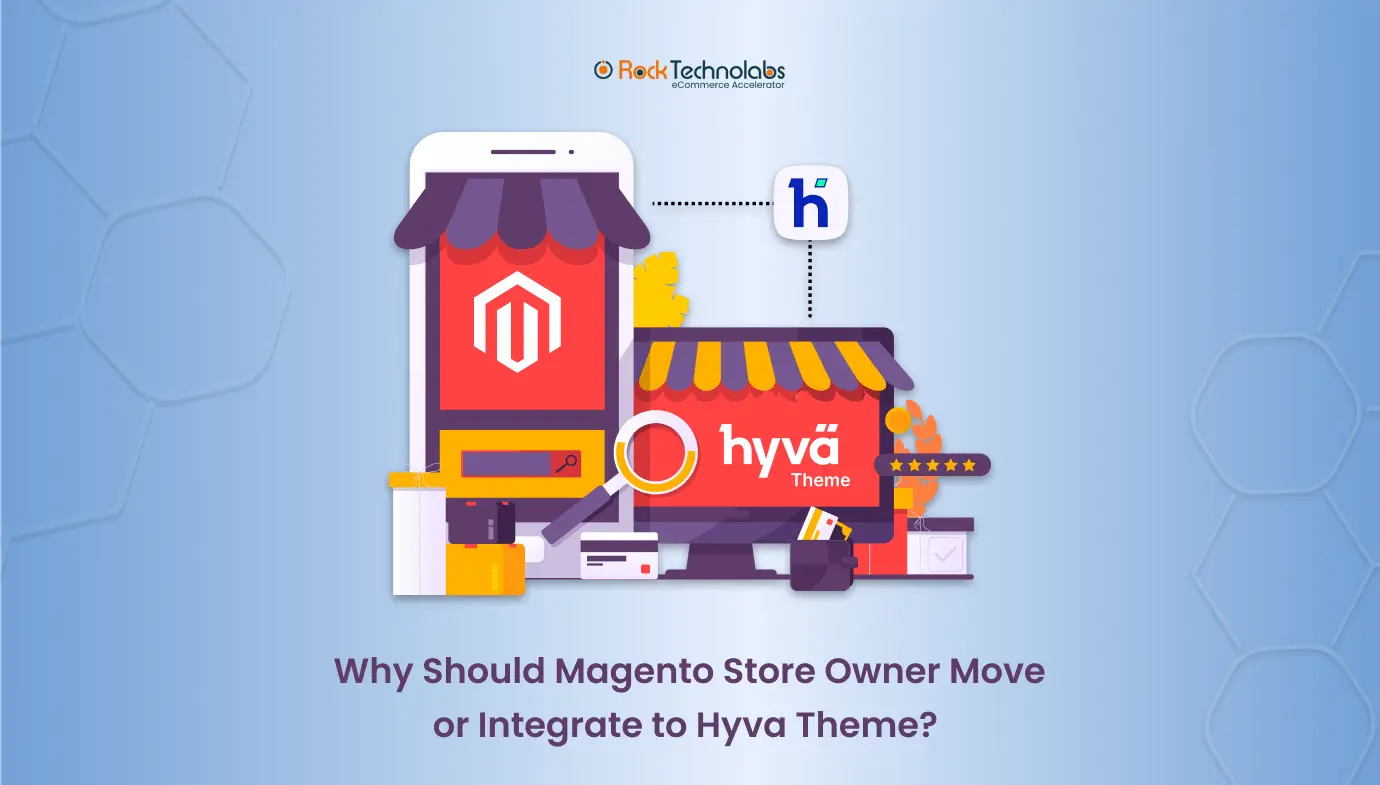Why Should Magento Store Owners Move or Integrate to Hyva Theme?

Magento Hyva theme is a strong option for Magento store owners because of the huge advantages it will bring to their eCommerce business. It can help serve an optimal customer shopping experience with a simpler development process and lower costs. How does Hyva theme do that? Scroll down to uncover its five spectacular benefits and a brief walkthrough of integrating the theme into your online store!
What is Hyva Theme?
Hyva Themes is a modern and performance-focused front-end solution for Magento 2 e-commerce stores. It takes advantage of a headless architecture, which indicates that the presentation layer (what users see) and the backend (data and logic) are completely separate. This feature leads to many benefits that eCommerce stores can leverage to win new customers and enhance their loyalty.
5 Benefits of Moving or Integrating to Hyva Magento Theme
The Magento Hyva theme is a popular option because of the many amazing advantages it can bring to your eCommerce store. This section will focus on three main aspects that the Magento 2 theme significantly impacts, including your customer shopping experience, online business management, and ease for developers.
1. Improved Performance
The Magento Hyva theme can reduce your page weight thanks to its lean approach of using JavaScript to shift a large portion of the rendering process to the user’s browser. It allows you to build visual elements and page structure directly in the browser, resulting in a much lighter initial page load.
Hyva Theme adopts tools such as Alpine.js (a lightweight JavaScript library) and Tailwind CSS (a utility-first CSS framework). Both of them are famous for their small size and performance focus, which can decrease the amount of required codes to process the browser.
Moreover, using the Hyva themes development can help your online store update only necessary parts of the page when a change happens. It eliminates full-page refreshes, boosting the loading speed. So, your customers will have a much smoother and more responsive browsing experience in your store.
2. Enhanced Scalability and Flexibility
The point of less code requirement above indicates less complexity in your online store’s development. As a result, it alleviates the process of adjusting or expanding the features on your eCommerce site when your business scales up.
Hyva Theme also allows you to integrate with different front-end frameworks and headless CMS solutions; hence, you can be more flexible in your website content management while leveraging the strengths of each framework for specific functionalities.
3. Omnichannel Experience
This refers to how Hyva themes can optimize your customer experience across different touchpoints, such as websites and mobile apps. More specifically, it can maintain a centralized product data source, which ensures that your customers will access the same product information, pricing, and promotions regardless of the devices they use.
Online and offline integration:
In terms of offering customers a unified shopping experience, many click-and-mortar owners get their website integrated with the Magento POS to sync databases between online and physical stores. Seamless integration between these two sales sources will ease your business management while providing your customers with smooth and consistent experiences.
Visual Content Integration:
In today’s digital marketplace, integrating high-quality visual content, such as professional event photography, can significantly enhance your eCommerce site’s user engagement. High-resolution images and videos of your products or company events can provide a richer, more engaging user experience, encouraging longer site visits and higher conversion rates. Leveraging visual content effectively requires a theme that’s optimized for performance and visual appeal, much like the Magento 2 Hyva theme. With its focus on improved performance and scalability, Hyva allows for seamless incorporation of visually compelling content without compromising on site speed or user experience.
4. Improved Developer Experience
Hyva themes development eliminates the traditional Magento templating system based on PHP and complex XML layouts. It uses popular modern web development tools and practices such as Alpine.js, Vue.js, and Tailwind CSS.
These frameworks are more familiar to developers, which enables them to easily and quickly code the web according to your requirements. Hyva also promotes writing cleaner, more modular code that is easier to understand, maintain, and collaborate on.
These features will profoundly reduce the complexity of the development process. Developers do not have to learn new features or get used to complicated code language. Thus, increased productivity is what you can expect when they can handle all your requirements without encountering many challenges.
5. Reduced Total Cost of Ownership (TCO)
The simpler and more productive development process means your developers need a shorter amount of time to code and complete the whole thing. Therefore, it can reduce the costs you pay for developing manpower.
Hyva themes also alleviate the maintenance process thanks to its code structure and modular components. Hence, you can pay lower ongoing support costs for less developer time for routine tasks and updates.
How to Integrate Magento 2 Hyva Theme Into a Website
Integrating Hyva Themes into a Magento website requires some technical expertise. That’s why the best solution is to have a specialized team to handle this task for you. Yet, taking a brief walkthrough of the process will help you gain better insights and have better preparation for the execution stage. Here’s a simplified process for online store owners.
1. Before Integration Process
Before you begin, you should check the version your Magento store is running. It should be the version 2.4x or later. If the current version is old, you should update your Magento store to the latest one. Once your online store is ready, another factor you need to consider is your budget and development resources for this task.
If you have an internal team or employee who has competent development knowledge, especially eCommerce store development, you can leverage such a huge advantage to save costs and be more active in the process.
However, this scenario is not always common for every other eCommerce store owner. If so, you should consider the budget of hiring an agency specializing in Magento and Hyva integrations.
2. Integration Process
- Step 1 – Purchase and Download: You need to acquire a Hyva Theme license and download the source code from the official website.
- Step 2 – Installation: When the source code is ready, you can now get your developer to pace the code in the appropriate directory of your Magento installation to install Hyva themes.
- Step 3 – Configuration: After the installation completes, you can access your Magento admin panel and navigate to the configuration section. You can pick the desired store view there and set the Hyva themes as the default one.
- Step 4 – Customization: If you are happy with the default, you can skip this step. In case you want to explore extensive customization options to tailor your eCommerce store to your needs, Hyva themes offer you various choices that will not disappoint you. A head-up here is that this step requires developer expertise, so you really should have a specialized person in this field to join if your store needs customizing.
- Step 5 – Testing and Monitoring: After your online store is successfully integrated into Hyva themes, you should run thorough tests across devices and browsers. It helps you uncover errors to fix and adjust the site before making it live on your website.
3. After the Integration
If your Magento store is complex, migrating it into Hyva might involve additional steps and considerations. Moreover, the finished integration does not stop there, as it involves ongoing maintenance to update and customize the features or even expand the scale if your business grows. It reinforces how essentially the role of a specialized developer is in the process.
What Should You Consider?
The Hyva theme’s aforementioned benefits might be enough to convince you to integrate it into your online store. Yet, you should also learn its downsides or the points that you should consider before making your decision.
Having a look at the full landscape is always helpful for you to have an objective perspective and come up with optimal solutions. Here are some aspects for your consideration related to the integration of Hyva themes into your eCommerce store.
- Cost: Your budget should come as one of the first factors in the table for discussion and consideration. You should check whether your internal resources take over the process or if you need an outsourced team. Then, you can estimate the possible costs to meet the budgets you are able and willing to pay.
- Ease of Transition: As mentioned above, the transition from your traditional online store to the Hyva-integrated one can become complicated and require a lot of updates, especially with required customization and adjustments.
- Learning Curve: If you hire an expert agency in the Magento Hyva theme integration, the learning curve might not be your problem. Yet, if you let the internal team handle, who has technical knowledge yet might not be familiar with the Hyva theme development, you should know that the learning curve can prolong the process and influence productivity.
Conclusion
The Magento Hyva theme will transform your eCommerce store due to simpler but better-performing web development. Yet, the integration process of Hyva into your online store calls for technical knowledge and specialized skills. Thus, you should have an expert team to handle the tasks or at least give you insightful consultation. Contact us for tailored consultancy and solutions related to Magento development to optimize your eCommerce business.





